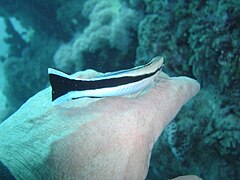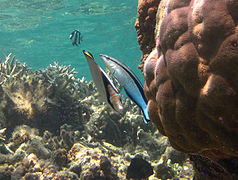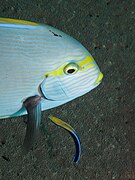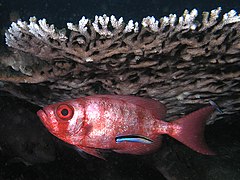Bluestreak cleaner wrasse
| Bluestreak cleaner wrasse | |
|---|---|

| |
| Scientific classification | |
| Domain: | Eukaryota |
| Kingdom: | Animalia |
| Phylum: | Chordata |
| Class: | Actinopterygii |
| Order: | Labriformes |
| Family: | Labridae |
| Genus: | Labroides |
| Species: | L. dimidiatus
|
| Binomial name | |
| Labroides dimidiatus (Valenciennes, 1839)
| |
| Synonyms[2] | |
| |
The bluestreak cleaner wrasse (Labroides dimidiatus) is one of several species of
Description
This is a small wrasse, averaging 10 cm (3.9 in) long, at most 14 cm (5.5 in). It can be recognized thanks to a wide longitudinal black stripe running along the side and eye; the back and the stomach are white (sometimes slightly yellowish). This white part changes to a bright blue on the front of the animal, while the black band widens at the tail. The young are black with an electric blue line.
A genetic analysis of L. dimidiatus revealed the population fell into two monophyletic clades, with Indian Ocean populations generally having different stripe widths to western Pacific fishes. The Japanese cleaner wrasses, though, fell within the same group as Indian Ocean fish, despite differing in appearance, and both clades overlap around Papua New Guinea.[5] Two closely related cleaner wrasse species, Labroides pectoralis and Labroides bicolor, were grouped inside the L. dimidiatus clade, so the bluestreak cleaner wrasse may in fact be polyphyletic, incorporating several species.[5]
Distribution
The bluestreak cleaner wrasse is found on coral reefs in the tropics from the Red Sea and Indian Ocean to the western Pacific (including Papua New Guinea, Japan, Fiji, and French Polynesia).[5] It was first recorded from the Kermadec Islands Marine Reserve north of New Zealand in 2015, after researchers examined hundreds of hours of unused documentary film footage.[6][7]
Cleaning

Cleaner wrasses are usually found at cleaning stations. Cleaning stations are occupied by different units of cleaner wrasses, such as a group of youths, a pair of adults, or a group of females accompanied by a dominant male. When visitors come near the cleaning stations, the cleaner wrasses greet the visitors by performing a dance-like motion in which they move their rear up and down.[8] The visitors are referred to as "clients". Bluestreak cleaner wrasses clean to consume ectoparasites on client fish for food. The bigger fish recognise them as cleaner fish because they have a lateral stripe along the length of their bodies,[9] and by their movement patterns. Cleaner wrasses greet visitors in an effort to secure the food source and cleaning opportunity with the client. Upon recognising the cleaner and successfully soliciting its attention, the client fish adopts a species-specific pose to allow the cleaner access to its body surface, gills and sometimes mouth.[citation needed] Other fish that engage in such cleaning behavior include goby fish (Elacatinus spp.)[10] The bluestreak cleaner wrasse is known to clean balaenopteridae, chondrichthyans, homaridae, octopodidae, and dermochelyidae.
-
L. dimidiatus with a client surgeonfish at a cleaning station
-
Cleaner Wrasse with a client Moray eel
-
Video of L. dimidiatus cleaning the gills of Acanthurus mata
Some fish
In different regions, the bluestreak cleaner wrasse displays various degrees of dependency on clients' ectoparasites as a primary food source. In tidal environments such as the Great Barrier Reef, the bluestreak cleaner wrasse is a facultative cleaner that feeds more on corals than on fish clientele.[12] Juvenile bluestreak cleaners are seen to bite their clients more often than the adults within that region, thus changing the dynamic of the known mutualistic relationship.[12] However, in regions where the bluestreak cleaners are solely dependent on clients' parasites, fish who have access to cleaning services have better body condition than those without cleaner access.[13] In the Marsa Bareika of the Ras Mohamed Nature Reserve, Egypt, the bluestreak cleaner wrasse live in specific sectors of the shallow reefs and are shown to rely on ectoparasites from species such as the brown surgeonfish and white belly damselfish.[13] In this region, fish that visit cleaner wrasses have lower antibody responses than those without cleaner access, suggesting that cleaner access may decrease the need for active immunity.[13]
Reproduction
Cleaner wrasse males defend specific living territories from other males in which they are able to have control over the females in those territories. When the dominant male no longer exists in that territory, one of the larger females is able to change sexes to take control over that territory. [14]
References
- . Retrieved 19 November 2021.
- ^ Eschmeyer, William N.; Fricke, Ron & van der Laan, Richard (eds.). Labroides "Species in the genus 'Labroides'". Catalog of Fishes. California Academy of Sciences. Retrieved 13 January 2020.
- ^ Côté, I.M. (2000). "Evolution and ecology of cleaning symbioses in the sea". Oceanography and Marine Biology: An Annual Review. 38 (1): 311–355.
- ^ Johnson, M.L. (2012). "High street cleaners". Biodiversity Science. Archived from the original on 2022-01-25. Retrieved 2012-02-04.
- ^ S2CID 17804061.
- PMID 32081990.
- ^ Hancock, Farah (16 March 2020). "New species accidentally discovered on film". Newsroom. Retrieved 2020-03-16.
- ^ Froese, Rainer. "Labroides dimidiatus". FishBase. Retrieved 16 September 2013.
- S2CID 53299983.
- .
- S2CID 85772684.
- ^ S2CID 214041635.
- ^ S2CID 18666960.
- ISSN 0179-1613.
Further reading
- Meulengracht-Madsen, Jens: (1976) Akvariefisk i farger, J.W. Cappelens forlag AS
- Labroides dimidiatus at FishBase
External links
 Data related to Labroides dimidiatus at Wikispecies
Data related to Labroides dimidiatus at Wikispecies Media related to Labroides dimidiatus at Wikimedia Commons
Media related to Labroides dimidiatus at Wikimedia Commons- Photos of Bluestreak cleaner wrasse on Sealife Collection








